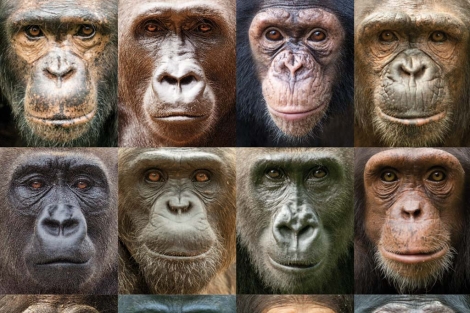The genomics era took a giant step with the publication of the complete sequence of human DNA in 2002. Since then, in an attempt to try to understand what makes us human, has sequenced the genetic information of men and women of different races and backgrounds. And also has done the same job with the closest living evolutionary relatives, the great apes: chimpanzee, orangutan, bonobo and gorilla. But the job lasted more than a decade, until he was able to decipher the DNA of the gorilla in 2012 . The rapid advance of the sequencing techniques and therefore the quality of the sequences allowing getting difficult to analyze the comparative genomic for recent evolutionary history of the human being. You can say that although the information was all contained in the same language, each had a different accent.
That just changed thanks to research led by scientist Evolutionary Biology Institute of Barcelona (a joint center of the University Pompeu Fabra and CSIC) Tomas Marques-Bonet and published in the prestigious scientific journal Nature. For the first time, we have obtained the genomes of hundreds of human beings and of all species of chimpanzees, orangutans, bonobos and gorillas (except the mountain gorilla , famous for the film about the life of Dian Fossey "Gorillas in the Mist ') with the same technique and comparison so that is reliable and accurate. Somehow, all of which have been deciphered exactly the same language.
"The goal is to have a database of all the great apes with the same technology we use in humans. Way we can compare apples with pears and apples to apples," says Marques-Bonet ELMUNDO.es. In addition, work has gone a step further. Until now, the scientific community had a large catalog of human sequences from African ethnic Papuans San or New Guinea to Europe and Asia, but only had a sample to compare each of the other species of great apes. The international team led by researchers at the Institute of Evolutionary Biology provided in addition to the human sequences were known, the genomes of 79 individuals (captive and wild) representing all species of these animals.
The elusive key to humanity
Although researchers involved in the analysis of dozens of research centers such as the University of Washington, the Oxford or Stanford genomics department at the stage of Spanish science sequencing also has taken the lead thanks to the work of the National Center Genomic analysis that loaded with 85% of the genomes.
Perhaps the main response that anyone would get is if now we know what makes us human. But unfortunately, we still have an affirmative answer. However, the conclusions of the work closes 30-year debate on the theory of Professor Maynard V. Olson about whether what makes us human is all the genetic information that we have lost along the evolution, the theory known as Less is more (less is more). "As a geneticist is very frustrating almost 80 grades apes analyze and compare hundreds of humans and not finding what makes us human. But keep looking," says Marques-Bonet.
As recognized by the researcher, the next step is to look at epigenetic regulatory mechanisms that direct the genome and gene functions decide what, when and how. Somehow, it gives credit to the researcher Mary-Claire King, who in 1975 concluded that since human sequences and great apes were almost identical, what distinguishes a chimpanzee to a human being is not in the succession of the letters of the genetic code, but how, when and why these letters are read DNA.
Another contribution of this work is that rewrites the evolutionary history of the lineage of humans changing the times of speciation and divergence of humans and chimpanzees, and the ancestor of these with the gorilla and so backward to reconstruct the evolution of the group in the last 15 million years. "This is the first time you make a data set specifically designed for this, so it is very difficult to refute and become a benchmark insurance hereinafter," says principal investigator.
Diversity reduction
In addition, the researchers found that human genomes show very low variability compared with the genome of most of the great apes. Few species of apes show very low levels. "This reduction in genetic diversity is usually the result of a process called a bottleneck, characterized by a dramatic decrease in the number of individuals in the population," says Javier Prado-Martinez, a doctoral student at the Institute of Evolutionary Biology and co -first author of the study.
This has allowed to define and characterize genetic data the precise moment when they became called 'Out of Africa', the time when early humans left the continent to colonize the rest of the planet over the millennia.
According Marques-Bonet, these results also have a direct application in conservation biology of these species of apes, both in the wild and in zoos. At present, many researchers in the field trying to define areas of influence and subspecies habitats gorillas and chimpanzees or samples taken for this hair or droppings that can not compare with barely anything. "Now they have a genetic tool with nearly 90 million markers that distinguish subspecies with a short analysis of a few places in the genome, this will undoubtedly improve the management of individuals," says geneticist.
But zoos could characterize what subspecies are about 500 individuals who are in Europe, which is not known at present and difficult crossing and animal conservation. Genotyping all those guys cost about 100,000 euros, a very small amount and would solve many problems for managing these facilities. However, there are good times for poetry and, so far, has not found any institution willing to provide that money.
